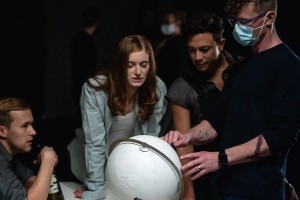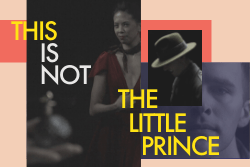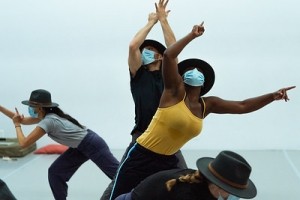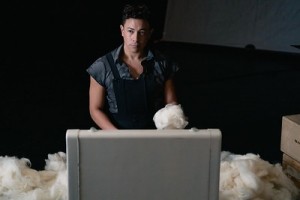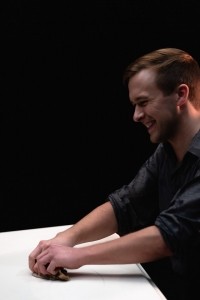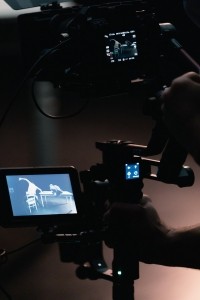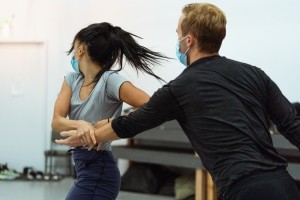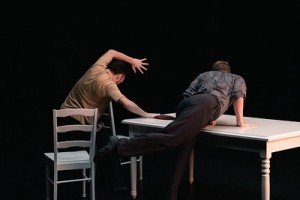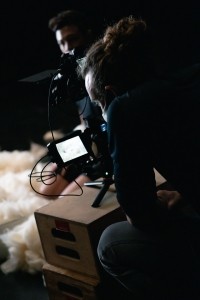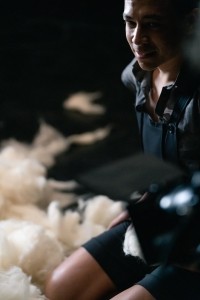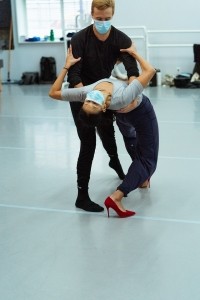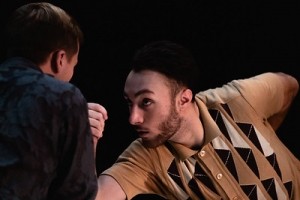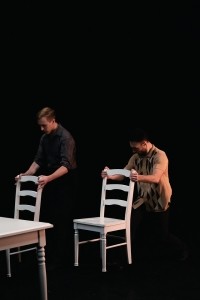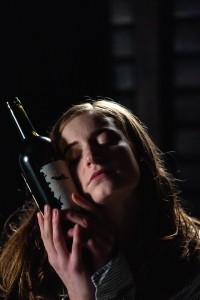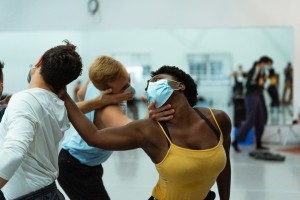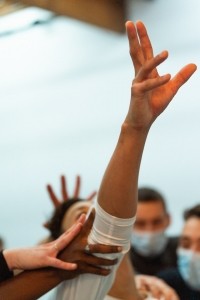The particular flavor, interest, and originality of Whim W’Him’s This Is Not The Little Prince—among the multitudinous versions of this beloved classic—is choreographer Olivier Wevers‘s decision to delve into relations between art and life in the genesis of the book. He conceives of the Little Prince and the Pilot both as separate entities and two aspects of writer Antoine de Saint-Exupéry. TINTLP premiered on stage in June 2019. A new production, rethought and reconfigured for film, will launch on January 28, 2021 on the company’s IN-WITH-WHIM platform.
Dualities abounded in the original undertaking and even more in the current one. The writer’s life vs the story in his book. The Little Prince vs The Author/Antoine/The Pilot. The stage version vs this month’s film. Acting vs dancing. But in fact, such a binary approach, as if just one side of opposition could hold at any given moment, does not do justice to the myriad facets of This Is Not The Little Prince. The spotlight might shine on the factual—the Saint-Exupéry family huddled around the radio listening to news of the war, say—or the fictional—the Prince seeking his particular Rose in the bevy of look-alike roses who are not his love. But the alternative perspective is always there—subtly or brazenly commenting on, adjusting, reflecting, embroidering—adding to the depth of the total picture.
In the film as on the stage, dance and acting intertwine throughout, but with a different balance between them. The change in medium profoundly affects the performers’ experience. So, for this post, I have asked the dancers to comment for themselves on the making and meaning of TINTLP. Since I haven’t been able to go to rehearsals in the usual way, the dancers’ verbal perspective will allow a special glimpse into the process and their approach to the characters they portray.
The separation between art and life, and its unity, are most explicitly addressed by the duo of Prince and Pilot. Jim Kent is the Little Prince. In Jim’s mind, there is not a huge difference between stage and movie in intention or story. Mainly, he says, “The volume is amped up, for the little prince and some of the intentions. There are moments of all the Little Prince’s expected qualities, but more so.” The Prince “is not exactly mischievous, but he’s very playful, cheeky. In the film, I play up all of that. To me the Prince represents the joy, magic, wonder, creativity in the story that adults have quashed in the Pilot. He reignites what’s just a glimmer in the Pilot/Antoine’s eye.” Karl Watson as the Pilot/Author/Antoine characterizes the Little Prince as “a bit of a Puck or sprite, not totally pure either. He has a bit of roughness, mischief in him. He finds the fantasy and dreams in the Pilot. And really draws him back into them.”
“On stage,” Jim says, “the choreography holds a lot of power, in physically being there. But for the film, I use my face more. Back and forth between the fanciful and human qualities. I need to show imagination and wonder in other ways” than purely through dance movement. He becomes “more actor, less dancer.” On stage, it’s more abstract. “The film is more literal-minded. There is more story.” But it veers toward Antoine de Saint-Exupéry’s biographical story rather than more of the book’s plot. Karl concurs on both points. “I definitely feel more connected to the idea of St Ex than to the book” now, he says. “Different locations and effects can bring character to biography—or rather to the metaphor of [the writer’s] life, more than in the stage version. We talked about it so much all ready for the stage, and it’s got to be different on film, because of scale, closeness, time—time passes differently.”
As in all of Olivier’s work, there’s a great deal of concentration on detail. Expression and acting become critical for the film. “Olivier is still relying on bodies. There’s still lots of complex partnering. We can’t just speak [as in non-dance films]. The focus is on movement, of course, and we can’t let it turn into pantomime. I am still a dancer—I have a need for that. It’s an artistic choice not to speak—and for it not to seem like an odd silent film.” It can’t dissolve into a mere exercise. “It must feel emotionally charged, yes charged.”
There is, however, an essential difference for the dancers between stage performance and film. As Karl puts it, in shooting a film, “You don’t have the adrenalin of the moment.” The dancers generally agree that it’s good for them when scenes can be shot in order and from start to finish. But that’s not how it’s always done. Karl adds, “You can’t just go through—there are different camera effects.” Always you have to consider, in Jim’s words, “The position and point of view of the cameraman. Sometimes we have the luxury of seeing what’s been shot [but not always]. It’s out of our control. So now it’s more at the moment. Tell the story. You have to understand the trajectory of the moment, knowing the scene backward and forwards.”
Karl talks about finding the motivations in every instant. “Why, here, do I go back to the table? How quickly do I react? When, exactly, do I nod my head? It’s not just press Play. It’s choreographed but there are different layers. Decision-making becomes more piecemeal. It’s really hard—great to create artistic output that others can see, but I don’t consider it a performance.” In each moment of the filming, “It’s up to me now. I have to deliver. Making quick choices. Different each time. It is interesting to negotiate.” Yet his input, though essential, occurs at one stage in the process. He and the other dancers provide a panoply of takes, an array of shots. “I make choices in doing [each of these],” says Karl, “but then there is Olivier as a choreographer and also Quinn” Wharton, the cinematographer.
Live, on stage the dancer’s choices are what the audience sees. The choreographer or stager may offer notes after it’s over, and the next performance will likely reflect those. But that’s for a different show, a different audience. In a film, the final choices, about the arc of the whole finished project and about each solo, duet or ensemble scene within it, are made by others. The film as a work of art is ‘corrected’ or at any rate ‘curated’ in the wake of the danced act, by not just the choreographer but the filmmaker. It’s an added layer shaping the finished product. The dancers meanwhile become part of the audience.
And then in the end there exists The Film, persisting long afterward as an objective fact. This is quite an altered perspective from the memories of dancers and spectators or the reviews of any particular enactment, of which there are several (or many) in the course of a stage run. With live performances, there is no single ‘definitive,’ seeable-again-and-again, afterward version. Each show is unique. We never quite know what surprise it will hold.
And yet, lest this seems like a eulogy for better times and other media, a film allows for all sorts of approaches to story, staging, and movement outside the limits of theatrical performance. “I can’t imagine doing this from scratch for a 50-minute film,” Karl exclaims. A new kind of richness is created.
Partly that has to do with props and effects not accessible to the stage production (see earlier blog post). Partly it means changing inflections and bringing out connections not yet unearthed in the original. None of the characters in the book on TINTLP is simple. The relationship between the central two characters-in-one becomes even more complex in the film, as noted above. “In the first version, the emphasis was on the inner child, innocence,” Karl says and on the Pilot/Antoine’s struggle to get back to that. Now, Karl feels, the stormy relationship with The Rose/Consuelo, Saint-Exupéry’s wife, is paramount. “I think that a part of him enjoyed the tumult of the relationship.” For his part, the Prince, says Jim, “nurtures the relationship with the Rose on his planet, and can’t stop thinking of her.” In the film, Jim is always in or on the edge of scenes between Karl and Liane Aung, who is both the Rose and Consuelo. Liane herself says of This Is Not The Little Prince, “In its first iteration, Consuelo was much more one-dimensional—her relationship with Saint-Ex was challenging from both perspectives. Now, in its film version, I think about the curve of Consuelo’s relationship with Saint-Ex. What my actual personality ups and downs entail in each moment, within each step that I’m taking. The film conveys such an important aspect of story building that it’s been challenging for me to embody such a spicy, rotten, moody, and self-indulgent character.”
In the book, mitigating and changing the Prince’s bleak sense of loneliness away from his planet and his Rose is the Fox, danced by Michael Arellano. And yet, in This Is Not The Little Prince (both versions) it is Karl as Antoine/the Pilot whom the Fox approaches, rather than Jim the Prince as in the book. Michael found the rehearsing and filming process “fun because it [was] pushing us to think of acting bits, in the closer shots and Olivier’s details, highlighting conversational things between characters.” He relishes “the hesitance of the Fox to approach Karl. He’s a bit skittish, but once he makes a move to approach, he has a playful trickster quality. He uses the table to give himself an advantage,” sidling up to Antoine, pouncing across from him. “A fox could have bad intentions, but I know the Fox wants to share something with him—to teach him and learn from him.
“Karl places a chair. Me too. I grab Karl’s face and whisper in his ear a secret about the Rose: ‘One sees clearly only with the heart, invisible to the eye.’ I think that the fox is such a crucial character. In the arc of this scene, the Fox is having that one climactic moment. It’s enough to change one and redefine the relationship of [the Little Prince/Antoine] with the Rose. It makes him realize what makes the Rose special, particular. That relationship is realized through the fox.”
Wherever he roamed, whether in his guise as a writer, Pilot, airman or Prince, flight, literal and figurative, was the one constant of Saint-Exupéry’s life. Jane Cracovaner is the shape-shifter of TINTLP. All the dancers except the principal duo transform at one moment or the other, into roses or the tail of a snake or Liane’s lovers, in addition to their named parts. But Jane takes the most parts of anyone. As kind of a master of ceremonies in ‘the Travel Section,’ she mimes a drunkard, doles out happy pills, counts up money in a top hat & white mustache, manipulates puppets (by Stephanie Sachs) of dictators as they squabble over a crown, thus signifying the many ways of being in the world that the central figure encounters but rejects. In Karl’s opinion, “the Little Prince an amalgam—a little voice, helping [the Pilot/Antoine] in accessing himself and his experiences—not just always to run out into the world. He is drawing him out of himself and looking into himself—I don’t think Saint-Ex knew how to be with himself.” The Lamplighter, danced by Ashley Green tries to light his way, but it is difficult. Karl goes on to say that Saint-Exupéry was “always searching in his other writings—but never got there until The Little Prince.“
The writer’s quintessential insights were in that book, to be sure, but it is not entirely clear whether, in his own life, he learned the lessons his book has taught to so many other people (probably grownups more than children): What we’re searching for always is closer than we think (represented in TINTLP, as in the book for the Pilot by the well found in the desert). The importance of the heart. We need not fly ceaselessly around the world to find what’s missing. “Adventures, love, flight,” he experienced them all to the fullest, “but,” says Karl, “he couldn’t be satisfied within himself. Unfortunately in the end wasn’t really able to.”
In the book, the fraught nature of the Prince/Rose connection is symbolized or embodied by the Snake, danced in the film by Andrew McShea. “He is a bit more theatrical in the film,” than the stage version, Andrew says. “The Snake is mysterious, comfortable in his body, his slinkiness.” It is interesting that Andrew believes, “The snake’s intentions are not necessarily bad, but there’s darkness there, he’s more ominous. He’s key to the change” in the Prince.
But we never really know what door that key opens. Is the Snake Comforter, Enabler, or Betrayer? In the book and in live or filmed dance performances alike, the Snake’s inscrutability (shadowed by the author’s own mysterious death in a plane crash 14 months after the publication of his final book) can be seen as beckoning the Prince to delusion and death or delivering him as promised back to his longed-for planet and his own true love.
